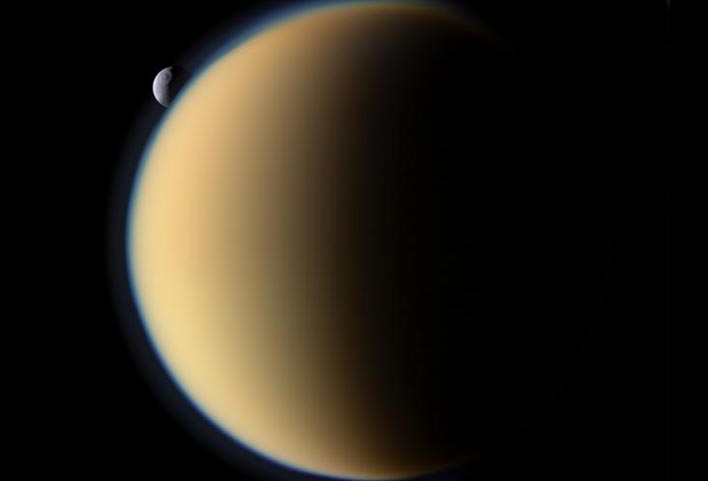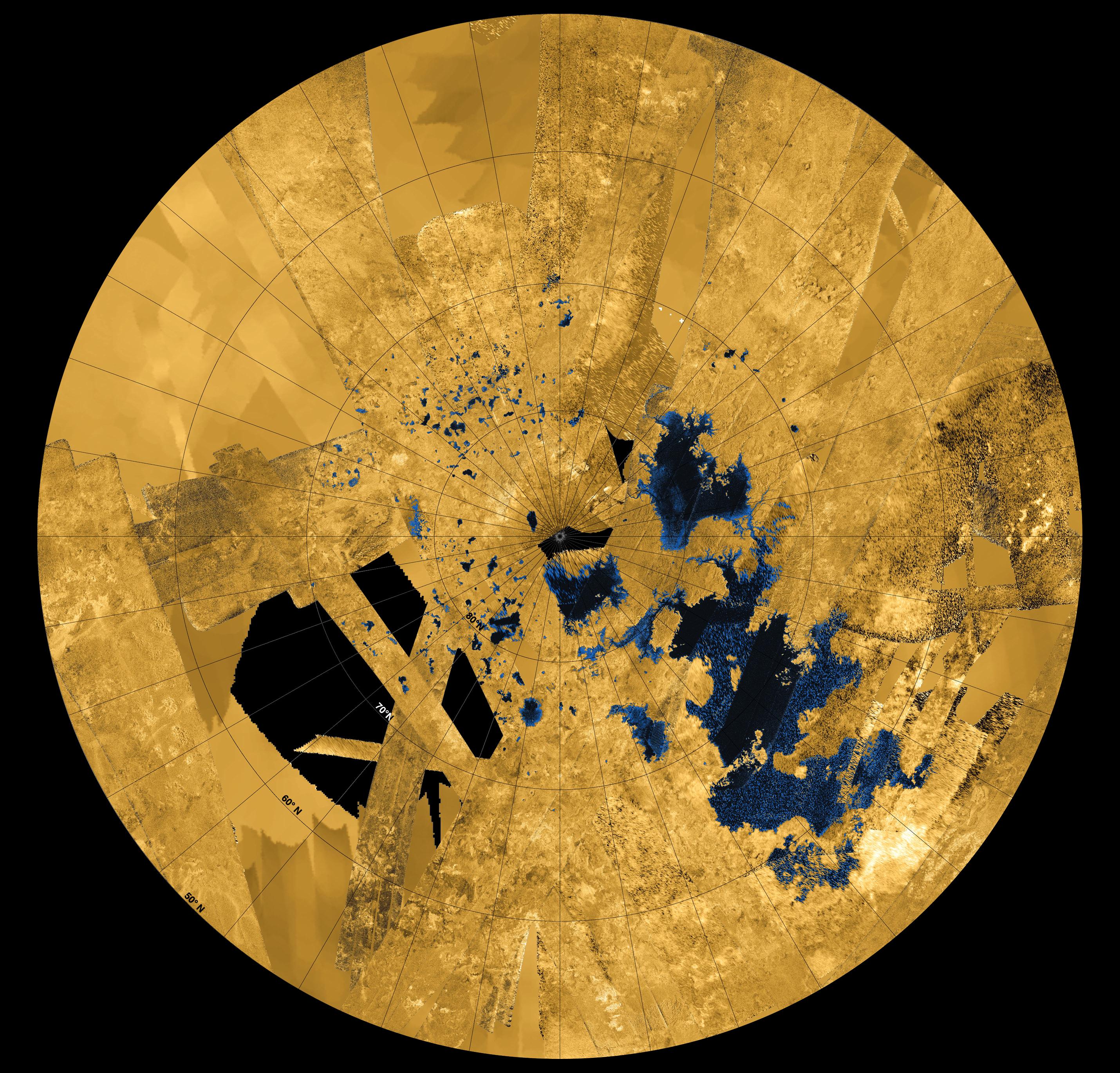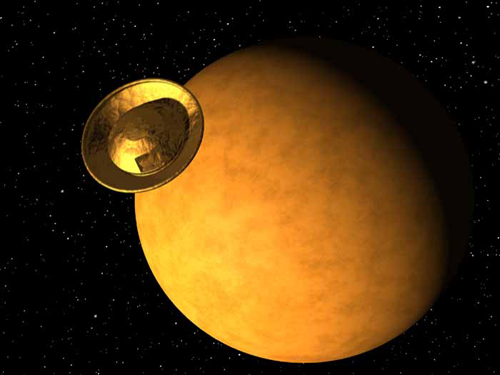How Did the Saturn Moon Titan's Atmosphere Form?

A decade ago, a tiny but mighty probe descended into the soupy atmosphere of Titan. This moon of Saturn is of great interest to astrobiologists because its chemistry and liquid cycle remind us of what the early Earth could have looked like before life arose.
The probe, called Huygens, made it to the surface and transmitted imagery all the way. It remained alive on the surface for more than an hour, transmitting data to NASA's orbiting Cassini spacecraft for later analysis by scientists.
During long-term missions, sometimes it takes years to examine all the data gathered by probes because there is so much for investigators to parse through. A decade later, we are only now starting to understand how the atmosphere of Titan formed, mostly based on what Huygens observed in January 2005. [What Huygens Saw on Titan (Video)]
The data could help settle a debate about how Titan got its atmosphere, said Christopher Glein, a postdoctoral researcher at the University of Toronto in Canada.

One scenario, more popular before Huygens reached the surface, suggested that the moon nabbed nitrogen, methane and noble gases that were floating in the solar system during formation. Another theory, and one that Glein supports, holds that the atmosphere was generated within Titan as a consequence of hydrothermal activity.
"That's the idea I am exploring — producing gases inside of Titan," Glein said.
His new paper, titled "Noble gases, nitrogen, and methane from the deep interior to the atmosphere of Titan," was published in the journal Icarus.
Get the Space.com Newsletter
Breaking space news, the latest updates on rocket launches, skywatching events and more!
Seeking noble gases
The Huygens probe found an isotope of argon — a noble gas also found in Earth's atmosphere — that appeared to be made within Titan's presumed rocky core. Argon-40 is a radioactive product that is formed from the radioactive decay of potassium-40. It originated inside of Titan, Glein said, and then got into the atmosphere by some means, perhaps by venting, or through cryovolcanism (cold volcanoes that may erupt mixtures of liquid water).
How the gas was released is a reflection of geophysical processes that depend on Titan's internal structure. Perhaps Titan is even warmer than thought. Some models predict that Titan's interior should be warm, but for that to happen its structure would need to be differentiated.
This could mean that Titan has (or once had) a hot rocky core surrounded by an ocean with an icy shell overlaid on top. This would be similar in structure to what is hypothesized on Jupiter's satellite Ganymede, the largest moon in the solar system, and unlike that of Callisto, another large moon of Jupiter that is mostly undifferentiated, Glein said. [Amazing Photos: Titan, Saturn's Largest Moon]
"There's not unanimous agreement," he added. "The key observation is the gravity field — which tells us how much mass separation occurred during the formation and evolution of Titan. If there is a rocky core and ocean-ice shell, there should be a great deal of separation. But Titan is a no-man's land of ambiguity between Ganymede and Callisto. We can't be definitive yet."
Glein's contribution to the body of knowledge on the origin of Titan’s atmosphere was to create a mathematical representation of Titan’s volatile element geochemistry, assuming that the moon is differentiated and the noble gases originated from the rocky core.
"I did some calculations and connected the dots together. This could all make sense in terms of a larger story," he said
Similarities and differences to Jovian moons
Glein assumed the building blocks of Titan would have a chemistry similar to a certain kind of ice that is reflective of primitive solar system material, such as comets. The carbon dioxide and ammonia found in these small bodies can produce methane and nitrogen if they are cooked in a hydrothermal system. Inside of Titan, it's possible this combination would account for the nitrogen and methane that now reside in its atmosphere.

According to Glein, some noble gases behave very similarly (in terms of how easily they form gases) to methane and nitrogen, which are the gases that give Titan an atmosphere. For example, nitrogen is similar to argon, and methane behaves similarly to krypton. These noble gas analogies allowed Glein to calculate how much methane and nitrogen can go from the rocky core to the atmosphere, a distance of at least 300 miles (500 kilometers).
For example, standard models show that the whiff of argon-36 detected by Huygens can be explained if only 2 percent of the total amount in the core make it out to the top. Similarly, nitrogen should also bleed outwards at about 2 percent, and Glein found that this is enough to explain the amount of nitrogen we find in Titan’s atmosphere. He came to a similar conclusion using krypton to estimate the outgassing percentage for methane.
The challenge is that much of the work is based on a single mission and only a few hours of data. While Cassini still makes regular flybys past Titan, its instruments (coupled with the greater distance) are not sensitive enough to gather precise abundances of trace noble gases that would improve on the Huygens results. Similarly, telescopic observations are hard because Titan is too far away for this exacting work.
"I think ultimately we are going to need another mission to Titan, such as a rover, and I think probably the Jupiter system more in the immediate future. There is useful information out there," Glein said.
"One of the next questions is trying to address why Ganymede and Callisto don't have atmospheres, like Titan," he added. "If we can get new data from Ganymede especially, we can test this model and get a general understanding of what’s going on. This is also a key next step in testing the hypothesis of a hydrothermal solar system, where heat sources inside icy worlds allow liquid water to persist, and drive geochemical transformations of carbon and nitrogen. This could set the stage for subsurface life."
NASA's forthcoming Juno mission arrives at Jupiter in 2016, and could help in terms of measuring Jupiter's global water abundance and explaining how its moons were formed from the gas cloud that birthed Jupiter, Glein said. Further ahead is Europe's JUICE mission, which will look at several of Jupiter's icy moons in the 2030s and could gather more information on Ganymede's chemistry and interior.
This story was provided by Astrobiology Magazine, a web-based publication sponsored by the NASA astrobiology program.
Follow Space.com @Spacedotcom, Facebookand Google+.
Join our Space Forums to keep talking space on the latest missions, night sky and more! And if you have a news tip, correction or comment, let us know at: community@space.com.

Elizabeth Howell (she/her), Ph.D., was a staff writer in the spaceflight channel between 2022 and 2024 specializing in Canadian space news. She was contributing writer for Space.com for 10 years from 2012 to 2024. Elizabeth's reporting includes multiple exclusives with the White House, leading world coverage about a lost-and-found space tomato on the International Space Station, witnessing five human spaceflight launches on two continents, flying parabolic, working inside a spacesuit, and participating in a simulated Mars mission. Her latest book, "Why Am I Taller?" (ECW Press, 2022) is co-written with astronaut Dave Williams.










